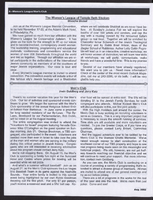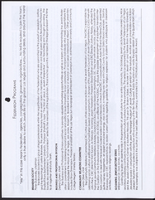Search the Special Collections and Archives Portal
Search Results

Meeting minutes for Consolidated Student Senate University of Nevada, Las Vegas, May 14, 1999
Date
1999-05-14
Archival Collection
Description
Includes meeting agenda and minutes, along with additional information about workshops. CSUN Session 29 Meeting Minutes and Agendas.
Text
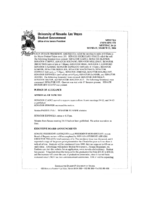
Meeting minutes for Consolidated Student Senate, University of Nevada, Las Vegas, March 22, 2004
Date
2004-03-22
Archival Collection
Description
Includes meeting minutes, along with additional information about letters.
Text
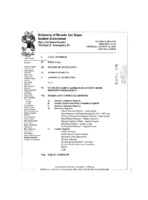
Meeting minutes for Consolidated Student Senate, University of Nevada, Las Vegas, August 25, 2003
Date
2003-08-25
Archival Collection
Description
Includes meeting minutes and agenda, along with additional information about bylaws
Text

Minutes from Temple Beth Sholom Board of Directors meetings, 1995-1996
Date
1995 to 1996
Archival Collection
Description
Meeting minutes include reports from committees of the board, correspondence, and balance sheets.
Text
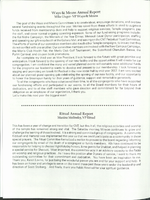
Annual report from Congregation Ner Tamid, 2006
Date
2006
Archival Collection
Description
Annual report from Congregation Ner Tamid, 2006
Text
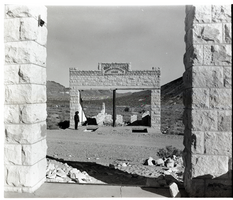
Film transparency of the ruins of the H. D. and L. D. Porter Brothers Store, Rhyolite, Nevada, November 25, 1948
Date
1948-11-25
Archival Collection
Description
An unidentified person looks at the ruins of the H. D. and L. D. Porter Brothers Store in Rhyolite, Nevada. The remains of two wooden buildings and several mining tailing piles are visible in the background. Originally from Illinois, the brothers opened their first store in Johannesburg, Ca. in 1902. Moving with the mining booms, they opened stores in Ballarat, Beatty, Pioneer and Rhyolite. From the Ballarat store, H. D. Porter loaded thirty tons of merchandise onto an 18-mule team freight wagon and came east across Death Valley to the Bullfrog District. The original store was built on Main St. After the move to Golden St., the wooden building was used as a furniture store for the Porter Brothers. With the purchase of a lot on Golden Ave. the construction of a new stone building began in July 1906 and was finished four months later. According to the Rhyolite Herald, November 1906 "This is a large substantial structure, practically fireproof, and occupies a prominent site on Golden Street. The main floor is 30 x 80 feet, with a basement and gallery." Nels Linn was the contractor who did the stonework. The estimated cost was $10,000 for the complete construction of the building. One of the signs that hung from the Porter Brothers Store was "All Things Good But Whiskey". With all the saloons already established in Rhyolite, the Porter Brothers maintained a reputation of never selling liquor. Rhyolite is a ghost town in Nye County, Nevada. It is in the Bullfrog Hills, about 120 miles (190 km) northwest of Las Vegas, near the eastern edge of Death Valley. The town began in early 1905 as one of several mining camps that sprang up after a prospecting discovery in the surrounding hills. During an ensuing gold rush, thousands of gold-seekers, developers, miners and service providers flocked to the Bullfrog Mining District. Many settled in Rhyolite, which lay in a sheltered desert basin near the region's biggest producer, the Montgomery Shoshone Mine. Rhyolite declined almost as rapidly as it rose. After the richest ore was exhausted, production fell. The 1906 San Francisco earthquake and the financial panic of 1907 made it more difficult to raise development capital. In 1908, investors in the Montgomery Shoshone Mine, concerned that it was overvalued, ordered an independent study. When the study's findings proved unfavorable, the company's stock value crashed, further restricting funding. By the end of 1910, the mine was operating at a loss, and it closed in 1911. By this time, many out-of-work miners had moved elsewhere, and Rhyolite's population dropped well below 1,000. By 1920, it was close to zero. After 1920, Rhyolite and its ruins became a tourist attraction and a setting for motion pictures. Most of its buildings crumbled, were salvaged for building materials, or were moved to nearby Beatty or other towns, although the railway depot and a house made chiefly of empty bottles were repaired and preserved. The town is named for rhyolite, an igneous rock composed of light-colored silicates, usually buff to pink and occasionally light gray. It belongs to the same rock class, felsic, as granite but is much less common.
Image

Genuine Auto Parts Neon Survey document, September 23, 2017
Date
2017-09-23
Archival Collection
Description
Information about the Genuine Auto Parts sign that sits at 3738 Boulder Hwy.
Site address: 3738 Boulder Hwy
Sign owner: Carquest Auto parts/ Golden State Supply/ Cannon Property LLC
Sign details: This building was built in 2014 which replaced a different Auto Parts building which still carried Car Quest. This location sells self-installation car parts. The sign itself was for the Charleston Auto Parts, but was restored for the Genuine Auto Parts around 2012/13 for its 2014 installation.
Sign condition: 5- Still in pristine condition since recently restored
Sign form: Roadside pylon sign
Sign-specific description: This sign has a long black steel base. The main portion of the sign is a steel orange jelly bean shape that has a yellow arrow surrounding it and points towards the building. The yellow arrow has flashing incandescents. Below the arrow states "Genuine" painted on the board in white block letters with a thin black trim. Underneath the word Genuine is a painted black square that has white letters spelling out "AUTO" and "PARTS" underneath, both in white neon. In between these words is the start of the yellow arrow. Under the black box is painted "3738 Boulder HWY" in the painted white block font with a thin black trim. This sign stays true to its original design for the Charleston Auto Parts sign with the arrow and Auto Parts words, and the only thing changed was the word Charleston to Genuine and the address from Main Street to Boulder Hwy.
Sign - type of display: Neon and Incandescent
Sign - media: Steel
Sign - non-neon treatments: Incandescent light bulbs
Sign animation: Flashing incandescent light bulbs
Sign environment: This location is on Boulder HWY with an RV sales lot next door. The original sign was located between Main and Charleston.
Sign - date of installation: 2014 in this location - original sign was for Charleston Auto Parts, but was restored for the Genuine Auto Parts around 2012/13 for its 2014 installation. Original installation year would have been circa 1950's
Sign - date of redesign/move: 2014 restored and put in this location though if it is the Charleston Auto Parts sign restored then the sign itself would date back to the 50's
Sign - thematic influences: This sign is remnant of the old time auto shop sign particularly with the arrow to accommodate to the car consumer era of the 50's/60's.
Sign - artistic significance: Restoring the sign and putting it back up for a similar purpose stays true to Vegas history by having the Neon live on.
Survey - research locations: Asessor's Page, Recapturist Website http://www.recapturist.com/portfolio/charleston-auto-parts/, Roadside Architecture website http://www.roadarch.com/signs/nvvegas2.html , Car Quest Auto Website https://www.carquest.com/stores/nv/las-vegas/14980
Survey - research notes: http://www.recapturist.com/portfolio/charleston-auto-parts/ shows this sign in its original form for the Charleston Auto Parts, but was restored for the Genuine Auto Parts around 2012/13 for its 2014 installation.
Surveyor: Emily Fellmer
Survey - date completed: 2017-09-23
Sign keywords: Neon; Incandescent; Steel; Flashing; Roadside; Pole sign; Directional
Site address: 3738 Boulder Hwy
Sign owner: Carquest Auto parts/ Golden State Supply/ Cannon Property LLC
Sign details: This building was built in 2014 which replaced a different Auto Parts building which still carried Car Quest. This location sells self-installation car parts. The sign itself was for the Charleston Auto Parts, but was restored for the Genuine Auto Parts around 2012/13 for its 2014 installation.
Sign condition: 5- Still in pristine condition since recently restored
Sign form: Roadside pylon sign
Sign-specific description: This sign has a long black steel base. The main portion of the sign is a steel orange jelly bean shape that has a yellow arrow surrounding it and points towards the building. The yellow arrow has flashing incandescents. Below the arrow states "Genuine" painted on the board in white block letters with a thin black trim. Underneath the word Genuine is a painted black square that has white letters spelling out "AUTO" and "PARTS" underneath, both in white neon. In between these words is the start of the yellow arrow. Under the black box is painted "3738 Boulder HWY" in the painted white block font with a thin black trim. This sign stays true to its original design for the Charleston Auto Parts sign with the arrow and Auto Parts words, and the only thing changed was the word Charleston to Genuine and the address from Main Street to Boulder Hwy.
Sign - type of display: Neon and Incandescent
Sign - media: Steel
Sign - non-neon treatments: Incandescent light bulbs
Sign animation: Flashing incandescent light bulbs
Sign environment: This location is on Boulder HWY with an RV sales lot next door. The original sign was located between Main and Charleston.
Sign - date of installation: 2014 in this location - original sign was for Charleston Auto Parts, but was restored for the Genuine Auto Parts around 2012/13 for its 2014 installation. Original installation year would have been circa 1950's
Sign - date of redesign/move: 2014 restored and put in this location though if it is the Charleston Auto Parts sign restored then the sign itself would date back to the 50's
Sign - thematic influences: This sign is remnant of the old time auto shop sign particularly with the arrow to accommodate to the car consumer era of the 50's/60's.
Sign - artistic significance: Restoring the sign and putting it back up for a similar purpose stays true to Vegas history by having the Neon live on.
Survey - research locations: Asessor's Page, Recapturist Website http://www.recapturist.com/portfolio/charleston-auto-parts/, Roadside Architecture website http://www.roadarch.com/signs/nvvegas2.html , Car Quest Auto Website https://www.carquest.com/stores/nv/las-vegas/14980
Survey - research notes: http://www.recapturist.com/portfolio/charleston-auto-parts/ shows this sign in its original form for the Charleston Auto Parts, but was restored for the Genuine Auto Parts around 2012/13 for its 2014 installation.
Surveyor: Emily Fellmer
Survey - date completed: 2017-09-23
Sign keywords: Neon; Incandescent; Steel; Flashing; Roadside; Pole sign; Directional
Text
Pagination
Refine my results
Content Type
Creator or Contributor
Subject
Archival Collection
Digital Project
Resource Type
Year
Material Type
Place
Language
Records Classification


